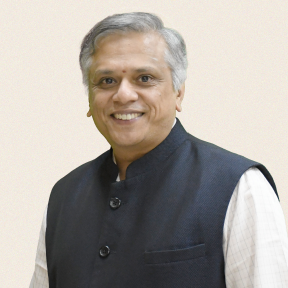
Prof. Mahesh Panchagnula
Professor of Applied Mechanics,
Dean, Alumni and Corporate Relations,
Faculty Associate, National Centre for Combustion R & D,
Indian Institute of Technology Madras
:
Mahesh Panchagnula

Prof. Mahesh V. Panchagnula is a Professor in the Department of Applied Mechanics at the Indian Institute of Technology Madras and a thought leader in engineering education, innovation, and public engagement. As the former Dean of Alumni and Corporate Relations at IIT Madras, he led transformative fundraising campaigns that significantly boosted support for research, infrastructure, and entrepreneurship.
Prof. Panchagnula has played a key role in building India's deep-tech ecosystem. He co-founded the IIT Madras Incubation Cell—now one of the leading startup hubs in the country—and helped establish Nirmaan, a pre-incubation initiative nurturing over 125 student-led ventures. His leadership has created pathways for aspiring technologists to translate their ideas into scalable solutions.
In a major outreach effort, he launched the “Prof. Mahesh Podcast. Future. Simplyfied.”, a weekly series designed to empower students and parents with insights into careers in science, engineering, and technology. The podcast features expert interviews, student Q&As, and multilingual summaries, addressing widespread anxiety around career planning and decision-making.
Prof. Panchagnula also heads the Center of Excellence in Sports Science & Analytics at IIT Madras, applying data-driven methods to enhance athlete performance and guide sports policy. His core technical interests span fluid mechanics, combustion, and system dynamics, complemented by his passion for education reform and science communication.
His multidimensional work aligns with the goals of ECM 2025, particularly its emphasis on energy systems, innovation, and societal transformation, making him a valued contributor to the conference.
Title: A Landscape Study of the Carbon Footprint of the Transportation Sector: Some Options for India
India’s transportation sector is at a critical crossroads, playing a dual role as an engine of economic growth and a major contributor to the nation’s carbon emissions. This abstract provides a comprehensive overview of the sector’s carbon footprint, the methodological nuances of emission accounting—particularly the distinction between tank-to-wheel (TTW) and well-to-wheel (WTW) analyses—and evaluates a suite of mitigation options tailored for India’s unique developmental trajectory.
As of 2024, transportation accounts for roughly 14% of India’s total energy-related CO₂ emissions, a share that is rising rapidly due to sustained urbanization, economic expansion, and increased demand for mobility. Road transport dominates the sector, responsible for nearly 90% of emissions, with freight trucks and commercial vehicles being especially significant contributors. The proliferation of internal combustion engine (ICE) vehicles has led to a doubling of sectoral emissions since 2000, and projections suggest that, without targeted interventions, transport emissions could exceed 20% of India’s total by 2030.
A central theme in contemporary emissions research is the methodological distinction between TTW and WTW frameworks. TTW analyses focus solely on emissions generated during vehicle operation—essentially, what comes out of the tailpipe. While this approach is useful for regulatory compliance and vehicle standards, it fails to account for upstream emissions associated with fuel production, refining, and electricity generation. In contrast, WTW studies offer a holistic perspective, encompassing both upstream (well-to-tank, WTT) and downstream (TTW) emissions, thereby providing a more accurate assessment of a vehicle’s true environmental impact.
Recent comparative studies underscore the importance of this distinction in the Indian context, where the electricity grid remains heavily reliant on coal. For instance, a 2024 HSBC Global Research report found that, under India’s current grid mix (approximately 26% non-fossil sources), hybrid vehicles exhibit 16% lower WTW emissions than battery electric vehicles (BEVs). Specifically, the study reported WTW emissions of 133 gCO₂/km for hybrids versus 158 gCO₂/km for BEVs, due to the high carbon intensity (716 gCO₂/kWh) of India’s electricity generation. The report projects that BEVs will only outperform hybrids on a WTW basis once the grid’s non-fossil share exceeds 44%—a milestone expected in the next decade as renewable deployment accelerates.
Similar findings emerge in the freight sector. The International Council on Clean Transportation (ICCT) and NITI Aayog’s 2024 studies on heavy-duty trucks indicate that zero-emission trucks (ZETs) could reduce WTW CO₂ emissions by up to 77% by 2070, but only if paired with aggressive grid decarbonization and green hydrogen adoption. Without these upstream changes, the WTW benefits of electrification are significantly diminished, highlighting the interdependence of vehicle technology and energy infrastructure.
Hydrogen fuel cell vehicles (FCEVs) also illustrate the complexity of WTW accounting. While FCEVs powered by green hydrogen can achieve near-zero WTW emissions, their overall energy efficiency is substantially lower than BEVs due to conversion and distribution losses. Recent European studies, such as the JEC Well-to-Wheels Consortium (2023), reinforce that no single technology or fuel pathway can achieve deep decarbonization in isolation; a portfolio approach leveraging electrification, advanced biofuels, and hydrogen is essential.
Given these insights, the study evaluates a range of decarbonization strategies for India. Electrification of public and private transport, especially through e-buses and two-wheelers, remains a high-impact option, but its effectiveness hinges on parallel investments in renewable energy. Modal shifts to public transit and non-motorized transport (NMT), such as cycling and walking, offer substantial emission reductions and co-benefits for urban air quality and congestion. Stricter fuel efficiency norms, promotion of alternative fuels (CNG, biofuels, hydrogen), and smart urban planning further complement the transition.
Policy recommendations center on developing India-specific WTW models to inform sectoral targets, accelerating grid decarbonization, incentivizing hybrids as a transitional solution, and mandating ZET adoption in freight corridors. Integrated policy frameworks, robust financing, and international cooperation for technology transfer are crucial enablers.
In conclusion, this landscape study demonstrates that India’s transport decarbonization is fundamentally a systems challenge, requiring simultaneous advances in vehicle technology, energy infrastructure, and policy design. WTW analysis emerges as an indispensable tool for guiding investments and regulations, ensuring that emission reductions are both real and sustainable. By adopting a holistic, evidence-based approach, India can not only curb the carbon footprint of its transportation sector but also set a global example for sustainable mobility in emerging economies.